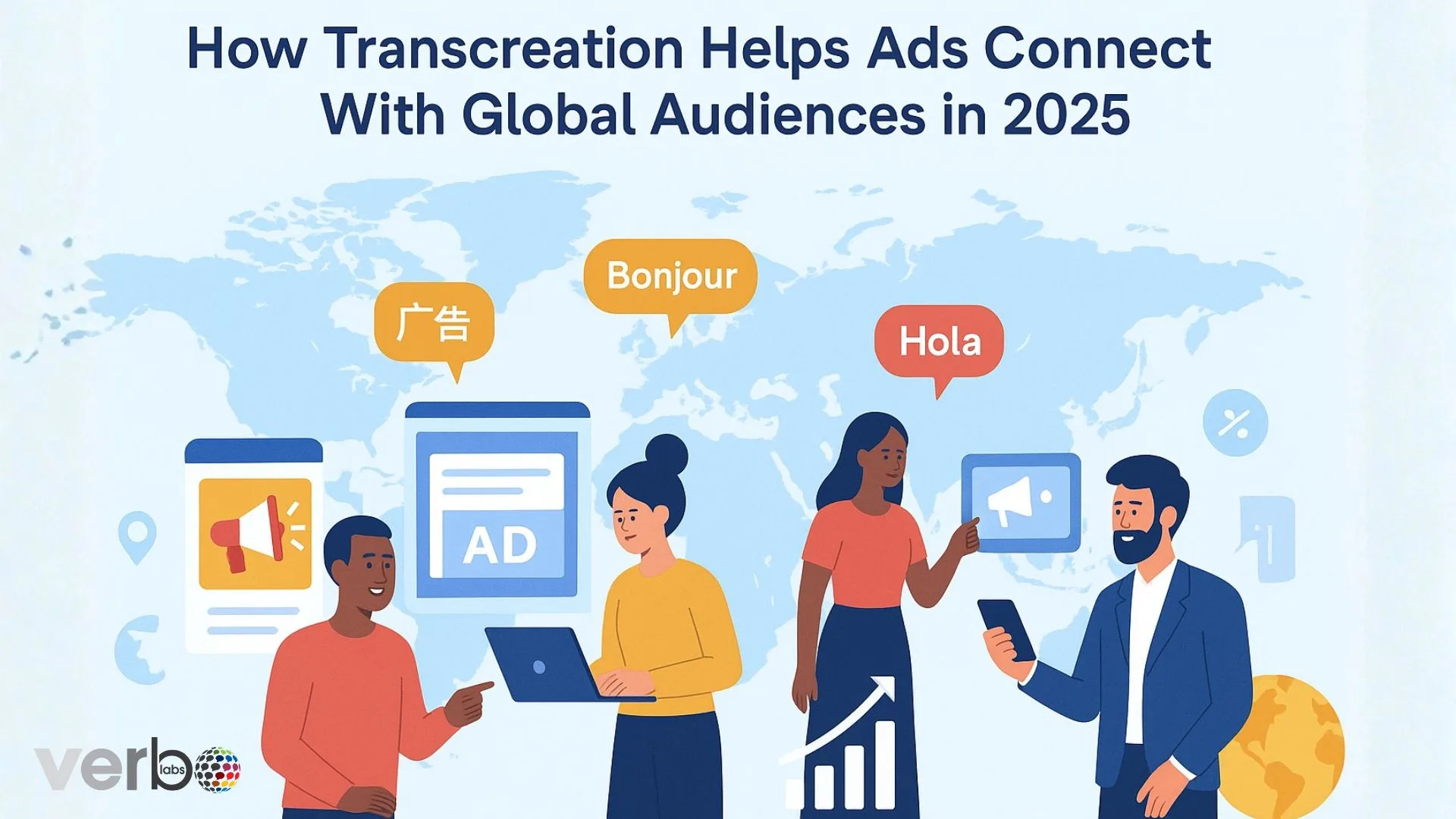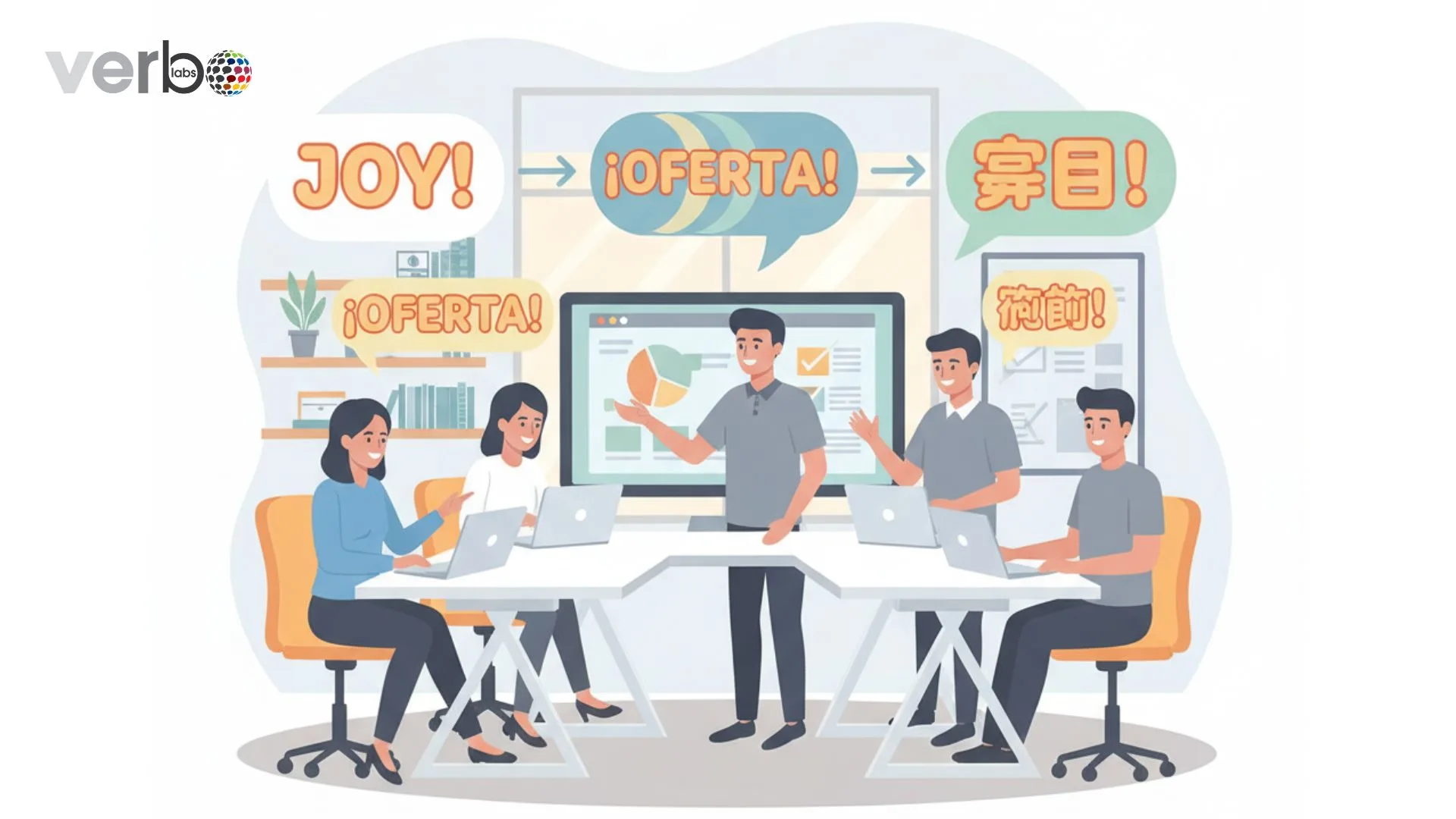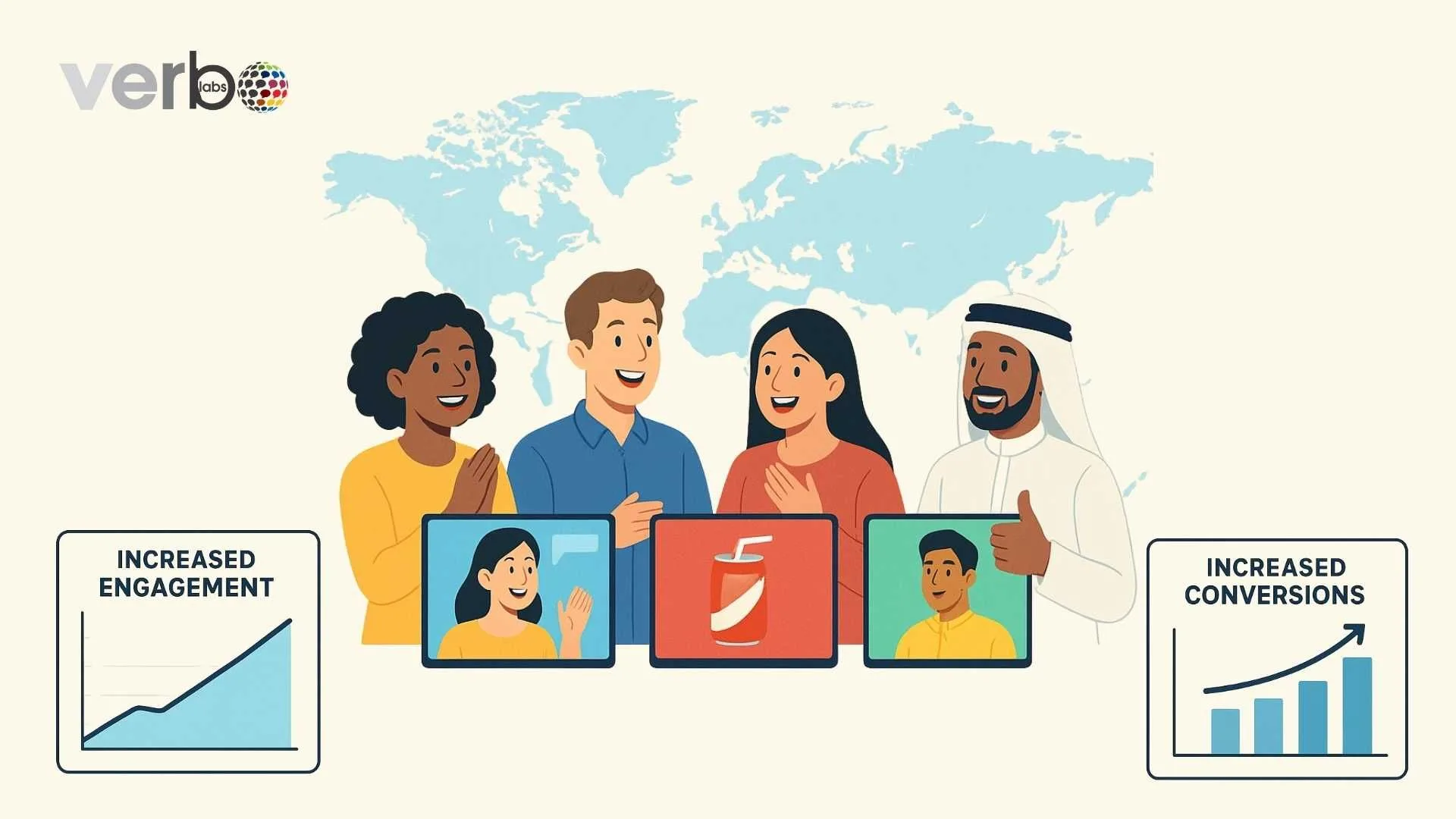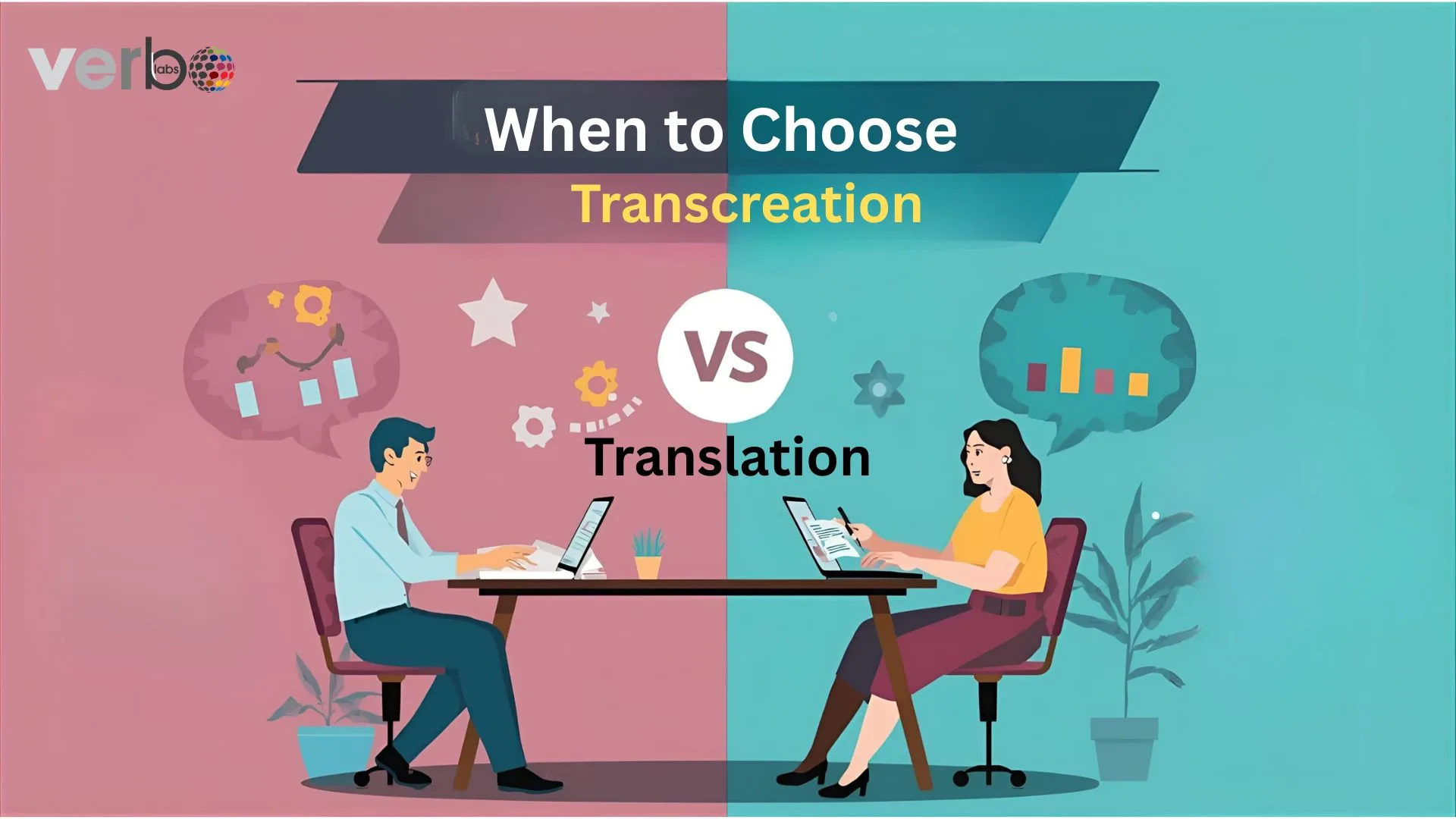
The global advertising market is massive. In 2025, it is projected to reach $583 billion, with a large portion of growth coming from non-English-speaking regions. For brands, this means one simple truth: connecting with audiences worldwide requires more than just translating words.
Research shows that 32% of consumers lose trust in a brand after experiencing poor localization. A poorly translated slogan, a culturally insensitive ad, or a literal tagline can harm a brand’s reputation and reduce sales.
What is Transcreation?

Transcreation is the process of adapting advertising content to new languages and cultures while preserving the original emotion, intent, and brand impact.
For global campaigns to succeed, brands must adapt their messaging not only linguistically but also emotionally. This is where transcreation becomes a critical strategy.
How It Differs from Translation
- Translation: Focuses on the accuracy of words. Example: converting an English sentence into Spanish with the same meaning.
- Transcreation: Focuses on emotional resonance and creativity.
- Example: Recreating an English slogan in Spanish so that it feels persuasive, funny, or inspiring within that culture.
Core Principles of Transcreation
- Creative Freedom – Translators may change words, metaphors, or idioms.
- Cultural Adaptation – Ads are adjusted to local values, traditions, and humor.
- Emotional Preservation – The audience should feel the same emotional impact as the original.
Framework for Transcreation
- Step 1: Cultural Brief – Understand the target culture’s values, humor, and sensitivities.
- Step 2: Creative Adaptation – Reimagine slogans, visuals, and brand tone.
- Step 3: Market Optimization – Test for local keywords, SEO, and compliance.
- Step 4: Testing – Run A/B testing in local markets to ensure resonance.
Why Transcreation Matters for Global Advertising Success

In today’s competitive global market, emotional connection and cultural relevance are key to ad performance. Transcreation goes beyond literal translation to ensure that campaigns resonate locally, improving both brand perception and ROI.
ROI & Business Impact
Research and case studies show clear benefits of transcreation for global brands:
- Conversion Rates: Ads adapted to local languages and culture can increase conversion rates by up to 30%.
- Engagement: Social media campaigns featuring culturally adapted content tend to achieve higher engagement compared to those with literal translations.
- Brand Trust: Consumers are more likely to trust brands that communicate in their native language.
- Cost Efficiency: Avoids expensive errors from miscommunication or culturally insensitive content.
Example: A global beverage brand localized its “Open Happiness” slogan across multiple markets using transcreation, increasing regional engagement and sales while maintaining brand identity.
KPIs to Track for Transcreation Success
When measuring the impact of transcreation in advertising, brands typically monitor:
- Conversions: How many users completed a purchase or action after seeing the ad.
- Sentiment Analysis: Social media reactions and customer feedback for cultural resonance.
- Revenue Growth: Sales uplift in localized markets versus English-only campaigns.
- SEO Visibility: Localized keywords, search queries, and AI-driven content discoverability.
AI Search Optimization + Transcreation

In 2025, AI-driven search engines, such as Google, ChatGPT, and Perplexity, will increasingly influence how consumers discover content. This makes transcreation not only about cultural adaptation but also about SEO and AI visibility.
Brands must ensure that their ads are both culturally relevant and algorithm-friendly to effectively reach global audiences.
Why AI Matters in Transcreation
- AI Overview Presence: Over 50% of search results now feature AI-generated summaries or direct answers. Properly transcreated content increases the likelihood of inclusion.
- Natural Language Queries: Consumers often use conversational queries, so ad copy must include localized phrasing that AI can parse.
- Voice Search Optimization: With smart assistants, queries are spoken in native languages, making accurate transcreation essential.
Best Practices for AI-Optimized Transcreation
- Use Local Query Phrasing: Adapt slogans, taglines, and ad text to reflect how local audiences search or speak naturally.
- Structured Data & Schema: Apply schema markup to multilingual ad campaigns to improve AI indexing and visibility.
- Conversational Tone: Prepare content for voice search, FAQs, and AI-friendly bullet points to enhance user experience.
- Topical Authority Clusters: Create related content hubs for each target market to establish authority in the local language.
- Integration with SEO Keywords: Align transcreated ad copy with localized keywords to improve click-through rates and ad relevance.
Global Brand Case Studies – Transcreation in Action
Transcreation is most effective when brands adapt their messaging to local cultures without losing emotion or impact. Several global companies have successfully leveraged transcreation to connect with audiences worldwide, demonstrating how cultural sensitivity and creative adaptation drive engagement and ROI.
1. Coca-Cola – “Open Happiness”
- Challenge: Coca-Cola’s slogan needed to resonate emotionally across diverse markets.
- Approach: The slogan was not directly translated. Instead, local expressions of joy and togetherness were used:
- In Japan: “Sharing a Smile”
- In Mexico: “Destapa la Felicidad” (Unleash Happiness)
- Outcome: Maintained emotional resonance, leading to stronger brand connection and higher consumer recall.
2. Netflix – Money Heist
- Challenge: The Spanish series “La Casa de Papel” had a title that didn’t convey the same excitement in all languages.
- Approach: The series name was adapted for each market while preserving suspense and intrigue.
- English-speaking markets: Money Heist
- French market: La Casa de Papel (kept original to retain mystery)
- Outcome: Successfully preserved cultural context and attracted global audiences without confusion.
3. IKEA – Multi-Market Campaigns
- Challenge: IKEA operates in 52 markets, each with unique cultural norms and humor.
- Approach: Catalogs, advertisements, and online content were transcreated rather than translated, using local idioms, cultural references, and measurement systems.
- Outcome: Increased engagement and conversion rates across all regions while maintaining IKEA’s global brand voice.
4. Pepsi – “Come Alive with the Pepsi Generation”
- Challenge: A literal translation in Taiwan was perceived as culturally inappropriate.
- Approach: Pepsi adapted the slogan to match local enthusiasm and youth culture, using phrases that conveyed energy and excitement.
- Outcome: Avoided brand missteps and strengthened local market appeal.
Industry-Specific Applications of Transcreation
Transcreation is not a one-size-fits-all solution. Each industry has unique challenges, tone requirements, and audience expectations. By applying transcreation strategically, businesses can ensure their ads, content, and campaigns resonate globally while staying culturally appropriate.
1. Technology & SaaS
Tech companies and SaaS providers frequently encounter complex product messaging, user interfaces, and onboarding content. Literal translation can confuse users or dilute the brand voice.
Transcreation Applications:
- Software UI/UX instructions localized for readability and clarity.
- Marketing emails, banners, and promotional videos are adapted to local idioms and tone.
- Onboarding tutorials translated while maintaining instructional tone and engagement.
Case Example: A SaaS company expanded to Latin America. Product guides were transcreated into Spanish variants, increasing user adoption by 30%.
2. E-commerce & Retail
E-commerce brands face high competition and diverse customer bases. Transcreation ensures that product descriptions, advertisements, and promotions resonate personally and persuasively in each market.
Transcreation Applications:
- Product titles and descriptions tailored for cultural relevance and local search habits.
- Promotional banners and ad campaigns are adapted with regional humor, trends, and idioms.
- Checkout and website flows localized for clarity and trust.
Case Example: A global fashion retailer used transcreation for seasonal campaigns in Asia and Europe, resulting in 25% higher click-through rates on localized ads compared to literal translations.
3. Healthcare & Pharmaceuticals
Healthcare advertising requires accuracy, compliance, and cultural sensitivity to ensure effective and culturally sensitive communication. Misinterpretation can have serious consequences, making transcreation a critical process.
Transcreation Applications:
- Patient-facing campaigns localized for language and cultural nuances.
- Pharma product ads adapted to comply with local regulations while preserving brand tone.
- Hospital websites and medical brochures are translated with patient safety in mind.
Case Example: A hospital network launched a multilingual ad campaign for wellness services. Transcreation ensured compliance with local regulations and cultural preferences, resulting in increased patient engagement and trust.
When to Choose Transcreation vs. Translation

Businesses often wonder whether they need transcreation or simple translation for their content. Choosing the right approach ensures effective communication, brand consistency, and cultural relevance.
Use Translation When:
- The content is factual, technical, or subject to regulation.
- Brand voice or humor is not critical.
- Accuracy is the top priority over emotional impact.
Use Transcreation When:
- You want your ad or campaign to resonate emotionally with local audiences.
- Humor, idioms, and cultural references are essential.
- Brand perception, persuasion, and engagement are key metrics that drive success.
Also Read:
- What is the Difference Between Transcreation and Translation?
- Subbing vs Dubbing: Which is Best for Your Content?
- Localization vs. Translation – What’s the Difference?
Framework to Implement a Transcreation Strategy
Creating a successful transcreation strategy requires careful planning, market understanding, and creative adaptation. Brands that follow a structured framework can ensure consistent messaging, cultural relevance, and maximum engagement across global markets.
Step 1: Market Research & Cultural Analysis
Before adapting content, it is crucial to understand the target market thoroughly. This includes:
- Cultural norms, values, and taboos
- Language variations and dialects
- Local consumer behavior and preferences
- Competitor campaigns and industry trends
Outcome: A cultural brief that guides all subsequent translation and localisation efforts.
Step 2: Content Strategy & Cultural Briefs
Next, define which content needs translation vs. transcreation.
Key actions:
- Identify ad campaigns, slogans, or promotional materials requiring emotional adaptation
- Outline tone, brand voice, and messaging goals
- Prepare reference materials and guidelines for translators.
Outcome: Clear instructions for creative teams to preserve brand identity while adapting to cultural differences.
Step 3: Creative Execution & Adaptation
This is the core of transcreation:
- Copywriters and linguists adjust the content to match local culture, humor, and emotion
- Visuals and graphics are also adapted to resonate with local audiences.
- A/B testing is conducted on key messaging to ensure engagement
Outcome: Culturally relevant, emotionally engaging content ready for deployment.
Step 4: Quality Assurance & Testing
Even the best-transcreated content must be reviewed for accuracy and cultural fit:
- Linguistic review by native speakers
- Cultural review by local consultants
- Compliance check for legal and regulatory requirements
Outcome: Content that is accurate, persuasive, and compliant.
Step 5: Scaling & Optimization
After successful testing, brands can scale campaigns to additional regions:
- Use translation memory and glossaries for consistency
- Continuously track KPIs: engagement, conversions, brand sentiment
- Refine content based on performance metrics and feedback
Outcome: Global campaigns that maintain emotional impact and brand consistency.
Future Trends in Transcreation for 2025 and Beyond

The field of transcreation is evolving rapidly as global brands face new challenges in language, culture, and technology. In 2025 and beyond, transcreation will not only focus on emotional and cultural adaptation but also integrate AI-driven tools, hyper-personalization, and multi-platform optimization to maximize engagement.
Understanding these trends helps businesses future-proof their advertising strategies.
1. AI-Powered Tools + Human Creativity
- AI-assisted transcreation speeds up initial drafts, offering suggestions for tone, cultural nuances, and localization.
- Human translators and copywriters remain essential for emotional resonance, idiomatic expressions, and brand voice.
- The hybrid approach ensures content is both accurate and culturally compelling.
Example: AI tools suggest local phrases for a campaign, while a native linguist fine-tunes the humor and emotion.
2. Multi-Platform Optimization
Global campaigns now span social media, search engines, e-commerce platforms, video streaming, and voice assistants. Transcreated content must be adapted to each platform:
- Short-form social media posts need catchy, concise messaging.
- Video ads require subtitling, dubbing, and culturally relevant visuals.
- Voice search and smart assistants demand conversational phrasing.
Impact: Ensures consistent brand voice and emotional impact across all touchpoints.
3. Hyper-Personalized Ads for Micro-Segments
Brands are moving beyond general localization to targeting micro-segments with personalized messaging. Transcreation allows campaigns to:
- Reflect regional dialects or language variations
- Adapt cultural references, idioms, and humor to local tastes
- Appeal to specific demographics with emotionally resonant messaging
Result: Higher engagement, trust, and conversion rates in each local market.
Measuring Success: Analytics & Continuous Optimization

Once a transcreation strategy is implemented, measuring its impact is crucial to ensure campaigns resonate with global audiences and achieve business objectives. Analytics and continuous optimization allow brands to track performance, refine messaging, and improve ROI across multiple markets.
1. Key Metrics to Track
To evaluate the effectiveness of transcreated campaigns, brands should monitor both quantitative and qualitative metrics:
Quantitative Metrics:
- Engagement Rate: Click-throughs, likes, shares, and comments on ads and social media posts.
- Conversion Rate: Percentage of audience completing desired actions (purchase, signup, download).
- Revenue Growth: Sales attributed to localized campaigns.
- Search Visibility: Rankings in local search engines, including AI-driven search results.
Qualitative Metrics:
- Brand Trust & Sentiment: Audience perception via surveys, feedback, and social listening.
- Cultural Relevance: Feedback on humor, idioms, and emotional tone.
- Message Clarity: Ensuring key campaign messages are understood in all markets.
2. Continuous Optimization Strategies
Transcreation is not a one-time process. Continuous optimization helps brands remain relevant and effective:
- Cultural Audits: Regularly evaluate campaigns for cultural appropriateness and emotional resonance to ensure they resonate with diverse audiences.
- Benchmarking: Compare performance across markets to identify which adaptations are most effective.
- A/B Testing: Experiment with different versions of translated content to see which drives higher engagement or conversions.
- Feedback Loops: Gather insights from local teams, customer reviews, and analytics to refine messaging.
- AI-Driven Insights: Leverage AI tools to identify trends, predict audience preferences, and optimize campaigns automatically.
3. Tools for Measuring Transcreation Success
Digital Tools & Platforms:
- Analytics Platforms: Google Analytics, social media insights, e-commerce dashboards.
- AI-Powered Monitoring: Tools that track sentiment, keyword performance, and conversational queries.
- Localization Management Systems: Track translation consistency, updates, and approvals across markets.
Conclusion
In today’s globally connected marketplace, simply translating advertising content is no longer enough. Brands must transcreate their campaigns—adapting messages for language, culture, and emotional impact—to truly connect with audiences across diverse regions.
Ready to take your ads global? VerboLabs specializes in professional transcreation services that help brands connect, engage, and succeed worldwide. From slogans and ad videos to websites and healthcare campaigns, VerboLabs combines AI efficiency with human creativity to deliver campaigns that truly resonate.
Contact VerboLabs to elevate your advertising campaigns with culturally sensitive, emotionally compelling, and globally optimized transcreation services.

Elevate your advertising campaigns with culturally sensitive, emotionally compelling, and globally optimized transcreation services.



